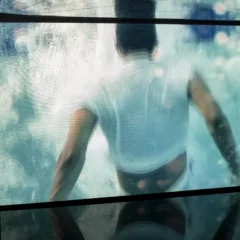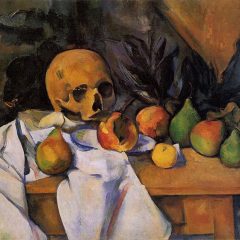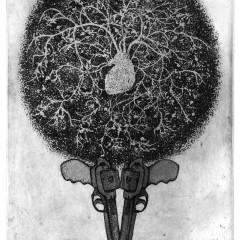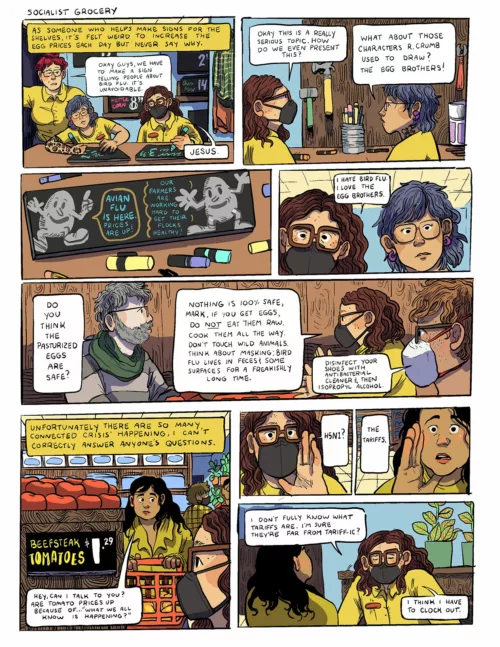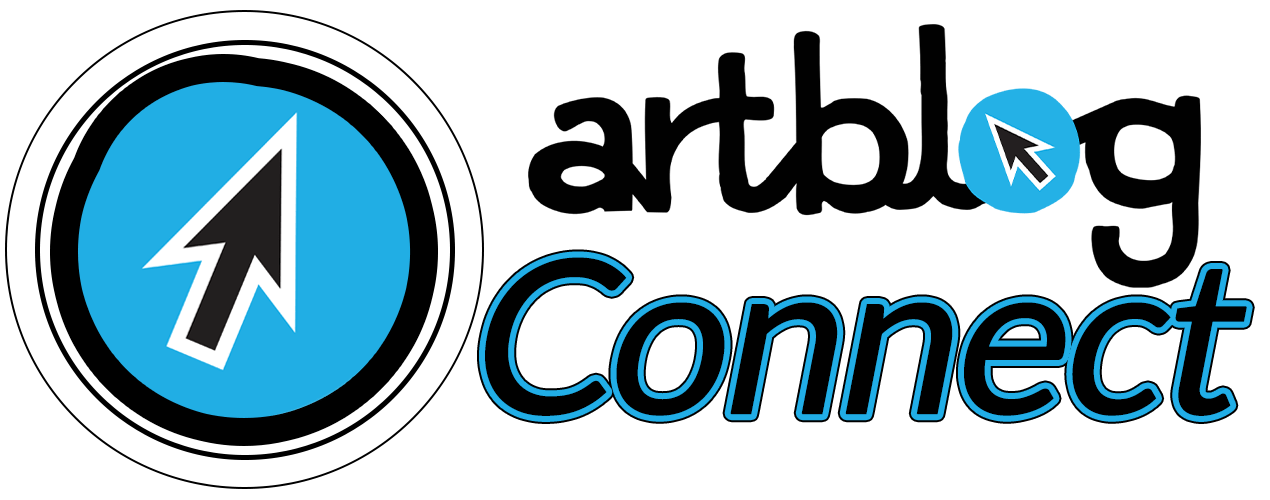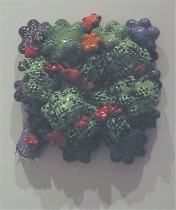 A show in which two of the participating six artists create landscapes with wax may not sound too promising at first blush, but the show, “Introduction’02” at Pentimenti Gallery is swell and would make a good First Friday stop.
A show in which two of the participating six artists create landscapes with wax may not sound too promising at first blush, but the show, “Introduction’02” at Pentimenti Gallery is swell and would make a good First Friday stop.
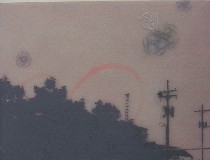 Brooklyn and New York artist Gloria Houng’s small landscapes, layered in layers of wax on small boards, exploit silhouettes and icon-like bits of our billboarded and communications-tower littered landscapes to create a thoroughly up-to-date take on the techno world around us. Houng focuses more on the sky and the treetops, not the land, to show the contrast between voluptuous nature and intrustive, rectilinear man-made structures. She also adds a tiny, tiny cow in each painting, a reference to nature unsullied and tended. Gestures and patterned swoops suggest the invisible communications that fly through the atmosphere (image, right, with cow on telephone pole crossbeam).
Brooklyn and New York artist Gloria Houng’s small landscapes, layered in layers of wax on small boards, exploit silhouettes and icon-like bits of our billboarded and communications-tower littered landscapes to create a thoroughly up-to-date take on the techno world around us. Houng focuses more on the sky and the treetops, not the land, to show the contrast between voluptuous nature and intrustive, rectilinear man-made structures. She also adds a tiny, tiny cow in each painting, a reference to nature unsullied and tended. Gestures and patterned swoops suggest the invisible communications that fly through the atmosphere (image, right, with cow on telephone pole crossbeam).
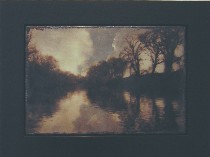 Houng’s modernity and her wary look at the world we have built stands in sharp contrast to Thea Schrack’s beautiful, encaustic-paint-coated color photographs.
Houng’s modernity and her wary look at the world we have built stands in sharp contrast to Thea Schrack’s beautiful, encaustic-paint-coated color photographs.
I’m not sure why I didn’t reject these out of hand as just more landscapes, but they seemed to be about memory and the transformation of fact into a kind of dreamscape. And speaking of the transformation of fact, although the image beneath is a photograph, Schrack often paints over and transforms what’s beneath to the point where the original photo is obscured and what’s shows is something entirely new. Most of these paintings use a river as the traditional landscape pathway that draws you in to the wilderness, in this case the Cosumnes River in California that Schrack had canoed, a place that appears to be unmarred by civilization. The breathtaking reflections on the water, the water’s merger into the landscape around it are not a new subject. But the work looked fresh, the edges declarations of materiality, the markmaking and brushwork on the images barely visible most of the time, melted into the encaustic method. A painting from a trip Schrack took to France, with the striped shadows cast by a row of cedars on a country path calling Van Gogh and Cezanne to mind, reveals a substratum of handwriting in the layers (image left, from Schrack’s Cosumnes River series).
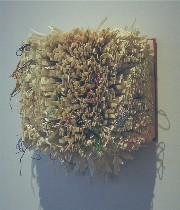 And speaking of layers and text, Mary Bennett, another left coaster, makes swell sculptures from old books by cutting and folding and sometimes stitching or tying the pages. The mappy inside covers speak to journeys of the mind, and the intensive folding speak to time traversed. In her artist’s statement, Bennett, a former corporate sort, wrote, “I am nost interested in using media that has a prior history where I can rework, reimagine, recontextualize or just make up a story” (image right, “The Winemakers,” mixed media & book, 8.25 x 12.25 x 6.5 inches).
And speaking of layers and text, Mary Bennett, another left coaster, makes swell sculptures from old books by cutting and folding and sometimes stitching or tying the pages. The mappy inside covers speak to journeys of the mind, and the intensive folding speak to time traversed. In her artist’s statement, Bennett, a former corporate sort, wrote, “I am nost interested in using media that has a prior history where I can rework, reimagine, recontextualize or just make up a story” (image right, “The Winemakers,” mixed media & book, 8.25 x 12.25 x 6.5 inches).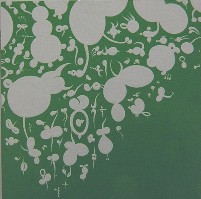 Aurora Robson’s paintings are at once cartoony and rich with paint. Some of the paintings, monochrome enamel with white figures on them, also have layers, some of the white figures painted over, the raised outlines from underneath revealed on the super-slick enamel surface (image left). The blobby shapes reminded me of Caspar the Friendly Ghost racing around and bumping into other blobs in the crowded atmosphere. The shapes also had floral allusions and suggestions of a repeat pattern that never quite materializes, but stays loose, uncommitted and verging on chaos. Another series of paintings by Robson suggested landscapes or sea scapes, with lots of compressed motion in the squiggly, loaded brush strokes. Robson, who grew up in Hawaii, works in New York, and will have her first solo show at Richard Levy Gallery in Albuquerque.
Aurora Robson’s paintings are at once cartoony and rich with paint. Some of the paintings, monochrome enamel with white figures on them, also have layers, some of the white figures painted over, the raised outlines from underneath revealed on the super-slick enamel surface (image left). The blobby shapes reminded me of Caspar the Friendly Ghost racing around and bumping into other blobs in the crowded atmosphere. The shapes also had floral allusions and suggestions of a repeat pattern that never quite materializes, but stays loose, uncommitted and verging on chaos. Another series of paintings by Robson suggested landscapes or sea scapes, with lots of compressed motion in the squiggly, loaded brush strokes. Robson, who grew up in Hawaii, works in New York, and will have her first solo show at Richard Levy Gallery in Albuquerque.
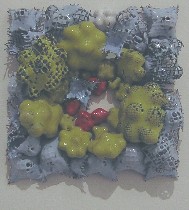 The only local artist in the group, Veleta Vancza, brings snappy color density to vitreous enamel over copper mesh to create small sculptural wall pieces that have a jewel-like intensity. These are not your refrigerator’s vitreous enamel; how nice if your refrigerator got a color infusion like this. Vancza, who last year had a Fleisher Challenge show (see post), has taken the imagery from the Josef Albers square to something more freeform–although still in a painterly rectangle, the visible bits of wire mesh suggesting a woven canvas (whereas all the paintings in this show are on board, not canvas!). This newer work, with its peek-a-boo voids and its ragged edges like torn fabric, are lovely. At the same time, their blobby popcorn-meets-bauble looks talk nicely to Robson’s comic white blob paintings (images right and at top of post).
The only local artist in the group, Veleta Vancza, brings snappy color density to vitreous enamel over copper mesh to create small sculptural wall pieces that have a jewel-like intensity. These are not your refrigerator’s vitreous enamel; how nice if your refrigerator got a color infusion like this. Vancza, who last year had a Fleisher Challenge show (see post), has taken the imagery from the Josef Albers square to something more freeform–although still in a painterly rectangle, the visible bits of wire mesh suggesting a woven canvas (whereas all the paintings in this show are on board, not canvas!). This newer work, with its peek-a-boo voids and its ragged edges like torn fabric, are lovely. At the same time, their blobby popcorn-meets-bauble looks talk nicely to Robson’s comic white blob paintings (images right and at top of post).
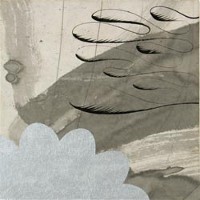 The sixth artist in the group is David Collins, another New Yorker, whose 10″ x 10″ squares on wood seem to offer portholes into space or somewhere else beyond the wall. Collins’ favorite strategy is contrast, and by layering less-juicy monotypes with the density of brushed-on marks and swatches, Collins creates a visual suprise. He also juxtaposes architectural and industrial and pop imagery with gesture. At the same time, there’s something restrained and Japanese about this work. A rakishly angled metal-looking pipe reminded me of James Rosenquist’s “F-111,” but the difference in scale and the focus on a labor-intensive method suggested these are anti-billboards, and something quite different is going on here–a process of charting space–outer space, geographic space, architectural space and maybe also inner space. I like the marks and the space and chart qualities, but in some of them, the exuberance is quenched by the restraint (image left, “Horimono 4”).
The sixth artist in the group is David Collins, another New Yorker, whose 10″ x 10″ squares on wood seem to offer portholes into space or somewhere else beyond the wall. Collins’ favorite strategy is contrast, and by layering less-juicy monotypes with the density of brushed-on marks and swatches, Collins creates a visual suprise. He also juxtaposes architectural and industrial and pop imagery with gesture. At the same time, there’s something restrained and Japanese about this work. A rakishly angled metal-looking pipe reminded me of James Rosenquist’s “F-111,” but the difference in scale and the focus on a labor-intensive method suggested these are anti-billboards, and something quite different is going on here–a process of charting space–outer space, geographic space, architectural space and maybe also inner space. I like the marks and the space and chart qualities, but in some of them, the exuberance is quenched by the restraint (image left, “Horimono 4”).

